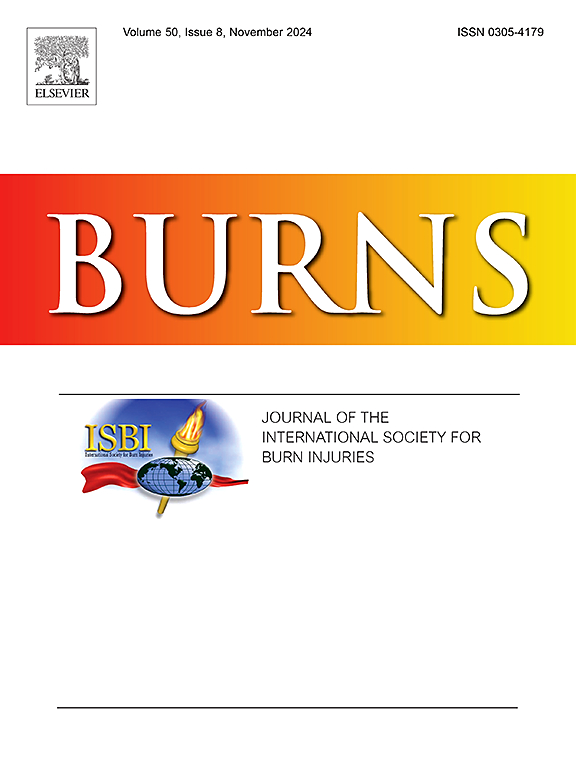Psychological assessment of adults with burn injuries in Lebanon
IF 3.2
3区 医学
Q2 CRITICAL CARE MEDICINE
引用次数: 0
Abstract
Background and objectives
Burned patients are frequently diagnosed with psychiatric disorders. This study aimed to determine the prevalence of probable post traumatic stress disorder (PTSD), and to assess growth and self-esteem among burned patients.
Subjects and methods
A cross-sectional quantitative study was performed, investigating the prevalence of probable PTSD among burned inpatients or outpatients over six years compared to a control group. 230 adult participants of whom 133 were burned patients and 97 non-burned subjects participated in the study.
Results
Inpatients exhibited higher PTSD Checklist for DSM-5 (PCL-5) scores (49.80 ± 23.44) when compared to outpatients (34.64 ± 31.15) and to the control group (42.73 ± 25.66) but regression analysis failed to show a statistical significance among the different groups. 18 % of burned patients met probable PTSD status based on the PCL-5. 10 % (10/102) of burned inpatients, 7 % (2/31) of burned outpatients and 9 % (9/97) of control group reported low self-esteem. Outpatients had significantly higher Rosenberg self-esteem scores (22.09 ± 4.53) compared to inpatients (18.38 ± 3.90) and the control group (p-value = 0.000). A lower educational level was associated with higher probable PTSD and a younger age was associated with higher post-traumatic growth.
Conclusion
Burned patients may develop low self-esteem, but they have been found to have high resilience and well-established personal growth.
黎巴嫩成人烧伤的心理评估
背景与目的烧伤患者常被诊断为精神障碍。本研究旨在确定可能的创伤后应激障碍(PTSD)的患病率,并评估烧伤患者的成长和自尊。研究对象和方法进行了一项横断面定量研究,调查了六年内烧伤住院患者或门诊患者中PTSD的患病率,并与对照组进行了比较。230名成年人参与了这项研究,其中133名是烧伤患者,97名是非烧伤患者。结果患者PTSD - DSM-5 (PCL-5)得分(49.80 ± 23.44)高于门诊患者(34.64 ± 31.15)和对照组(42.73 ± 25.66),但回归分析各组间差异无统计学意义。根据PCL-5, 18. %的烧伤患者符合可能的PTSD状态。烧伤住院患者中有10 %(10/102),烧伤门诊患者中有7 %(2/31),对照组中有9 %(9/97)自尊低下。门诊患者的Rosenberg自尊得分(22.09 ± 4.53)显著高于住院患者(18.38 ± 3.90)和对照组(p值= 0.000)。较低的教育水平与较高的创伤后应激障碍相关,较年轻的年龄与较高的创伤后生长相关。结论烧伤患者自尊水平较低,但具有较强的适应能力和良好的个人成长。
本文章由计算机程序翻译,如有差异,请以英文原文为准。
求助全文
约1分钟内获得全文
求助全文
来源期刊

Burns
医学-皮肤病学
CiteScore
4.50
自引率
18.50%
发文量
304
审稿时长
72 days
期刊介绍:
Burns aims to foster the exchange of information among all engaged in preventing and treating the effects of burns. The journal focuses on clinical, scientific and social aspects of these injuries and covers the prevention of the injury, the epidemiology of such injuries and all aspects of treatment including development of new techniques and technologies and verification of existing ones. Regular features include clinical and scientific papers, state of the art reviews and descriptions of burn-care in practice.
Topics covered by Burns include: the effects of smoke on man and animals, their tissues and cells; the responses to and treatment of patients and animals with chemical injuries to the skin; the biological and clinical effects of cold injuries; surgical techniques which are, or may be relevant to the treatment of burned patients during the acute or reconstructive phase following injury; well controlled laboratory studies of the effectiveness of anti-microbial agents on infection and new materials on scarring and healing; inflammatory responses to injury, effectiveness of related agents and other compounds used to modify the physiological and cellular responses to the injury; experimental studies of burns and the outcome of burn wound healing; regenerative medicine concerning the skin.
 求助内容:
求助内容: 应助结果提醒方式:
应助结果提醒方式:


